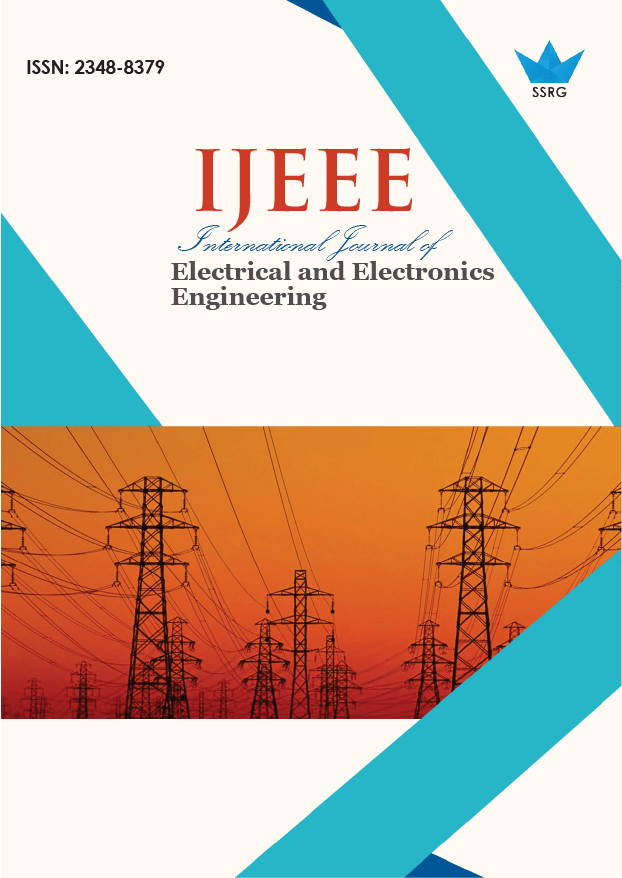Security Vulnerabilities and AI‐Driven Intrusion Detection in 5G Network Slicing Architectures

| International Journal of Electrical and Electronics Engineering |
| © 2025 by SSRG - IJEEE Journal |
| Volume 12 Issue 8 |
| Year of Publication : 2025 |
| Authors : Guntu Nooka Raju, Rebba Sasidhar, P Vamsi Sagar, Shaik Nannu Saheb, N.V.A. Ravi Kumar, Vasupalli Manoj |
How to Cite?
Guntu Nooka Raju, Rebba Sasidhar, P Vamsi Sagar, Shaik Nannu Saheb, N.V.A. Ravi Kumar, Vasupalli Manoj, "Security Vulnerabilities and AI‐Driven Intrusion Detection in 5G Network Slicing Architectures," SSRG International Journal of Electrical and Electronics Engineering, vol. 12, no. 8, pp. 269-279, 2025. Crossref, https://doi.org/10.14445/23488379/IJEEE-V12I8P123
Abstract:
Network slicing enables 5G networks to establish many virtualized, on-demand networks on one shared infrastructure, allowing for a wide range of use cases like the Internet of Things (IoT) and Ultra-Reliable Low-Latency Communications (URLLC). Although such flexibility in architectures is advantageous, it also vastly expands the attack surface, offering new forms of vulnerabilities like cross-slice attacks and shared resource exploitation. This paper examines these security vulnerabilities and suggests an AI-based intrusion detection system tailored to sliced 5G architectures. The scheme utilizes a Transformer-based model incorporating multi-head self-attention mechanisms to effectively recognize complex temporal relationships in network traffic. The model is trained and evaluated on typical 5G datasets, i.e., the 5G NIDD dataset, in varied realistic attack settings. The model performs multi-class classification - it both detects malicious traffic and classifies it into attack types (e.g., DDoS, port scan, protocol exploit). Comparative experiments on baseline models, i.e., Convolutional Neural Networks (CNN), Long Short-Term Memory networks (LSTM), ensemble Autoencoder-Support Vector Machines (AE/SVM), and Gradient Boosting, validate the enhanced performance of the Transformer-based intrusion detection system. Our Transformer model becomes approximately 99% accurate in detection, which is better than the CNN-based method (performed with ~92% accuracy), ensemble techniques (89.33% accuracy), and even traditional machine learning techniques such as Gradient Boosting (99.3% accuracy). These improvements are given in the tables provided, which illustrate the superiority of Transformer models for solving the new security issues of 5G network slicing. The results confirm that sophisticated AI methods-i.e., Transformer models-are a good solution to counter security threats in 5G networks. Future work will improve model interpretability and investigate integration into live operational network environments.
Keywords:
5G, Network slicing, Intrusion detection, Artificial Intelligence, Transformers.
References:
[1] Shujuan Gao et al., “Security Threats, Requirements and Recommendations on Creating 5G Network Slicing System: A Survey,” Electronics, vol. 13, no. 10, pp. 1-32, 2024.
[CrossRef] [Google Scholar] [Publisher Link]
[2] Zeina Allaw et al., “Cross-Layer Security for 5G/6G Network Slices: An SDN, NFV, and AI-Based Hybrid Framework,” Sensors, vol. 25, no. 11, pp. 1-20, 2025.
[CrossRef] [Google Scholar] [Publisher Link]
[3] Hamza Kheddar, “Transformers and Large Language Models for Efficient Intrusion Detection Systems: A Comprehensive Survey,” arXiv Preprint, 2024.
[CrossRef] [Google Scholar] [Publisher Link]
[4] Chiming Xi, Hui Wang, and Xubin Wang, “A Novel Multi-Scale Network Intrusion Detection Model with Transformer,” Scientific Reports, vol. 14, no. 1, pp. 1-17, 2024.
[CrossRef] [Google Scholar] [Publisher Link]
[5] Min-Gyu Kim, and Hwankuk Kim, “Ensemble Encoder-Based Attack Traffic Classification for Secure 5G Slicing Networks,” CMES: Computer Modeling in Engineering & Sciences, vol. 143, no. 2, pp. 345-360, 2024.
[CrossRef] [Google Scholar] [Publisher Link]
[6] Kinzah Noor et al., “A Review of Machine Learning and Transfer Learning Strategies for Intrusion Detection Systems in 5G and Beyond,” Mathematics, vol. 13, no. 7, pp. 1-63, 2025.
[CrossRef] [Google Scholar] [Publisher Link]
[7] Hussam N. Fakhouri et al., “A Comprehensive Study on the Role of Machine Learning in 5G Security: Challenges, Technologies, and Solutions,” Electronics, vol. 12, no. 22, pp. 1-44, 2023.
[CrossRef] [Google Scholar] [Publisher Link]
[8] Loukas Ilias et al., “Convolutional Neural Networks and Mixture of Experts for Intrusion Detection in 5G Networks and Beyond,” arXiv Preprint, 2024.
[CrossRef] [Google Scholar] [Publisher Link]
[9] Rodrigo Moreira et al., “An Intelligent Native Network Slicing Security Architecture Empowered by Federated Learning,” arXiv Preprint, 2024.
[CrossRef] [Google Scholar] [Publisher Link]
[10] Yalin E. Sagduyu, Tugba Erpek, and Yi Shi, “Adversarial Machine Learning for 5G Communications Security,” arXiv Preprint, 2021.
[CrossRef] [Google Scholar] [Publisher Link]
[11] Md Hasan Shahriar et al., “G-IDS: Generative Adversarial Networks Assisted Intrusion Detection System,” arXiv Preprint, 2020.
[CrossRef] [Google Scholar] [Publisher Link]
[12] Alcardo Alex Barakabitze et al., “5G Network Slicing using SDN and NFV: A Survey of Taxonomy, Architectures and Future Challenges,” arXiv Preprint, 2019.
[CrossRef] [Google Scholar] [Publisher Link]
[13] Ramraj Dangi et al., “ML-Based 5G Network Slicing Security: A Comprehensive Survey,” Future Internet, vol. 14, no. 4, pp. 1-28, 2022.
[CrossRef] [Google Scholar] [Publisher Link]
[14] Jiaqi Li, Zhifeng Zhao, and Rongpeng Li, “Machine Learning-Based IDS for Software-Defined 5G Network,” IET Networks, vol. 7, no. 2, pp. 53-60, 2018.
[CrossRef] [Google Scholar] [Publisher Link]
[15] Mohammad N. Alanazi, “5G Security Threat Landscape, AI and Blockchain,” Wireless Personal Communications, vol. 133, no. 3, pp. 1467-1482, 2023.
[CrossRef] [Google Scholar] [Publisher Link]
[16] Renato S. Silva et al., “REPEL: A Strategic Approach for Defending 5G Control Plane from DDoS Signalling Attacks,” IEEE Transactions on Network and Service Management, vol. 18, no. 3, pp. 3231-3243, 2020.
[CrossRef] [Google Scholar] [Publisher Link]
[17] Amir Afaq et al., “Machine Learning for 5G Security: Architecture, Recent Advances, and Challenges,” Ad Hoc Networks, vol. 123, 2021.
[CrossRef] [Google Scholar] [Publisher Link]
[18] Liqun Yang et al., “Real-Time Intrusion Detection in Wireless Network: A Deep Learning-Based Intelligent Mechanism,” IEEE Access, vol. 8, pp. 170128-170139, 2020.
[CrossRef] [Google Scholar] [Publisher Link]
[19] Sehan Samarakoon et al., “5G-NIDD: A Comprehensive Network Intrusion Detection Dataset Generated over 5G Wireless Network,” arXiv Preprint, 2022.
[CrossRef] [Google Scholar] [Publisher Link]
[20] Zhenyue Long et al., “A Transformer-Based Network Intrusion Detection Approach for Cloud Security,” Journal of Cloud Computing, vol. 13, no. 1, pp. 1-11, 2024.
[CrossRef] [Google Scholar] [Publisher Link]

 10.14445/23488379/IJEEE-V12I8P123
10.14445/23488379/IJEEE-V12I8P123